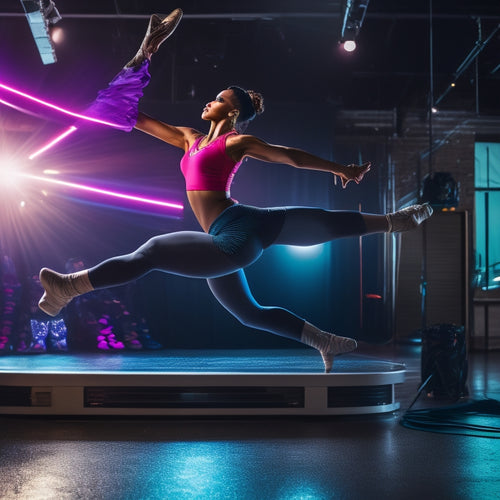
How Do You Roller Skate Without Falling?
Share
You're about to start your roller skating journey! Begin by getting familiar with your skates and their features. Warm up and stretch before hitting the ground to prevent injuries. Find a flat, open area to start rolling, and make sure to bend your knees for balance and stability. Keep your weight centered and look where you want to go - it's all about confidence! Practice gliding on one foot and learn to stop safely before you pick up speed. With these basics down, you'll be rolling in no time - and you're just getting started on your path to becoming a pro!
Key Takeaways
• Maintain a low center of gravity by bending your knees to increase stability and balance on roller skates.
• Keep your weight evenly distributed between both feet to prevent leaning and losing balance.
• Engage your core strength to improve stability and confidence on roller skates.
• Practice in a safe, flat, and obstacle-free area to reduce the risk of falling.
• Start slow, build confidence, and gradually increase speed to avoid losing control and falling.
Get Familiar With Your Skates
Take a few minutes to get acquainted with your roller skates, as understanding their parts and features is essential to your skating journey.
Familiarize yourself with the wheels, bearings, and brakes - it'll make a huge difference in your overall experience.
Regular skate maintenance is key to ensuring a smooth ride and preventing injuries. Check your skates regularly for worn-out parts and clean them often.
You can also customize your skates to fit your personal style - swap out wheels for a different feel or add colorful laces to make a statement.
Warm Up and Stretch First
Before you lace up and hit the rink, prepare your body to roll by warming up and stretching those key muscle groups. You're about to put your body through a new kind of movement, so it's crucial to get your muscles ready for the task.
Take 10-15 minutes to get your heart rate up with some light cardio, like jogging in place or jumping jacks. This will get your blood flowing and warm up your muscles. Next, move on to some flexibility exercises to improve your range of motion. Focus on stretches that target your legs, hips, and lower back, as these areas will be working the hardest.
Start on Flat Ground Only
Now that you're warmed up and stretched out, it's time to find the perfect spot to start rolling!
You'll want to find a flat, open area with no obstacles or rough patches to trip you up.
Start by finding a safe spot, checking your stance, and getting comfortable standing on your skates - you got this!
Find a Safe Spot
When you're ready to lace up and hit the pavement, look for a flat, open area with no obstacles or rough spots, where you can safely get a feel for your roller skates.
Avoid crowded areas, like skate parks or outdoor rinks, where more experienced skaters might be zooming by. Instead, opt for a quiet spot like an empty parking lot or a smooth bike path. This will give you the freedom to focus on finding your balance and getting comfortable on your skates.
Check Your Stance
Stand with your feet shoulder-width apart, toes pointing slightly outward, and your knees slightly bent, as if you're about to sit down in a chair. This is your starting stance, and it's essential to get it right.
Proper alignment is key to maintaining balance on your roller skates. Make sure your feet are parallel to each other and your weight is evenly distributed on both feet. Check your foot placement - are your feet pointing slightly outward? This will help you achieve a stable base.
Get Comfortable Standing
Find a flat, open space, like a basketball court or a smooth sidewalk, where you can practice standing comfortably on your roller skates without worrying about obstacles or inclines.
Stand with your feet shoulder-width apart, toes pointing slightly outward. Engage your core to maintain balance and stability. Feel the weight distribution on your wheels, keeping your knees slightly bent.
As you stand, focus on building ankle strength by shifting your weight from one foot to the other. Remember, you're not trying to move yet; just focus on getting comfortable standing on your skates.
Take deep breaths, relax, and enjoy the feeling of freedom on wheels!
Bend Your Knees for Balance
As you prepare to roll onto the skating floor, can you feel the stiffness in your legs, and are you wondering how to shed that rigidity to gain better balance? Relax, it's normal!
To improve your balance, focus on bending your knees. This simple technique will increase your knee flexibility, allowing you to move more smoothly and confidently on your skates. By bending your knees, you'll lower your center of gravity, making it easier to maintain balance.
Remember, the key is to keep your knees slightly bent, not stiff or locked. This will help you absorb any shocks or bumps on the floor, allowing you to glide effortlessly.
Keep Your Weight Centered
As you stand on your roller skates, you'll want to focus on keeping your weight centered over your feet.
This means distributing your weight evenly between both feet, with your knees bent and your body balanced evenly.
Stance Is Everything
When you step onto the roller skating rink, keep your weight evenly distributed on both feet, with your knees slightly bent, to maintain a stable stance that will help you glide with confidence.
As you stand, engage your core strength to support your balance and posture. This will help you feel more grounded and in control.
Remember, your stance is everything - it's the foundation of your roller skating experience. With a strong, centered stance, you'll build balance confidence and be able to move freely on the rink.
Balance Is Key
You'll find it's easier to stay upright and in control if you keep your weight centered over your feet, with your knees bent and your body positioned directly above your heels. This balance is key to roller skating without falling.
By keeping your weight centered, you'll be more stable and able to react to changes in your surroundings. It's also essential to engage your core strength to maintain good balance.
Posture Matters
Maintaining good posture is crucial, so keep your weight centered over your feet by imagining a vertical line running from the crown of your head to your heels, with your ears, hips, and ankles aligned. This will help you feel more stable and confident on your skates.
To achieve good posture, remember to:
- Engage your core muscles to support your lower back.
- Maintain a neutral spinal alignment, avoiding slouching or arching.
- Keep your shoulders relaxed and down, avoiding tension.
- Look ahead, keeping your gaze soft and focused.
Look Where You Want to Go
As you start moving on your roller skates, keep your eyes fixed on the direction you want to go, letting your body naturally follow the path you're visually creating. This is key to maintaining balance and control. Remember, your body follows your gaze, so Focus Forward and avoid looking down or back. Visual Alignment is essential – keep your eyes on the horizon or a point in front of you.
| Focus Tip | Benefits |
|---|---|
| Fix your gaze on a point ahead | Improves balance and control |
| Avoid looking down or back | Reduces likelihood of falling |
| Keep your eyes on the horizon | Increases confidence and freedom |
| Visualize your path | Enhances overall skating experience |
Practice Gliding on One Foot
Now that you've mastered the art of visual alignment, it's time to challenge your balance by practicing gliding on one foot. This will help you develop the ankle strength and stability you need to stay upright on your roller skates. Start by standing on one foot while holding onto a wall or chair for support.
As you get more comfortable, try gliding on one foot while keeping the other foot off the ground.
Here are some additional tips to help you practice gliding on one foot:
-
Start slow: Begin with short glides and gradually increase your distance as you build confidence.
-
Keep your knees bent: This will help you stay low and stable.
-
Engage your core: Keep your abs tight to support your balance.
- Practice single leg squats: This will help you build strength and stability in your ankles and legs.
Learn to Stop Safely First
You've built a strong foundation by practicing gliding on one foot, and now it's time to master the most critical skill in roller skating: stopping safely.
Don't let skate anxiety hold you back! Learning to stop confidently is key to enjoying your roller skating experience. Familiarize yourself with different stop techniques, such as the T-stop, heel brake, and plow stop.
Practice these techniques in a safe, open area until you feel comfortable. Remember, it's okay to start slow and build up your skills. With patience and practice, you'll be stopping like a pro in no time!
Take a Lesson or Two
Consider taking a lesson or two from a qualified instructor to help you build confidence on your roller skates and identify areas for improvement. Not only will you learn new skills, but you'll also gain valuable feedback to refine your technique.
Here are a few ways to find a qualified instructor:
-
Skate Schools: Look for local skate schools that offer group or private lessons.
-
Private Coaches: Search online for private coaches in your area who specialize in roller skating.
-
Skate Parks: Many skate parks offer lessons and workshops for skaters of all levels.
- Online Resources: Take online lessons or follow skate instructors on social media to learn new skills and get tips.
Frequently Asked Questions
Can I Roller Skate on Uneven or Rough Surfaces?
'Picture traversing a rocky road on wheels, but you're not stuck! You can conquer rough terrain with the right skate modifications, and with practice, you'll be gliding over bumps like a pro, feeling liberated and unstoppable!'
How Do I Handle Emergencies Like a Lost Skate or Broken Wheel?
When emergencies strike, don't panic! You've got this! Invest in Skate Insurance for peace of mind, and always carry a Wheel Backup to make sure you're never stuck in a sticky situation.
Are There Any Specific Skate Styles Better for Beginners?
When choosing your first skates, you'll find soft boots with stability features, like wider wheels, are perfect for beginners, providing more control and confidence, allowing you to glide freely and focus on having fun!
Can I Wear Any Type of Socks With My Roller Skates?
'Did you know that 72% of roller skaters wear the wrong socks, hindering their performance? You can wear moisture-wicking socks with arch support for best ankle support, but avoid cotton as it can cause blisters.'
How Long Does It Take to Become a Proficient Roller Skater?
You'll be gliding like a pro in no time! With regular skate frequency, you'll notice progress tracking your skills improving. Aim for 2-3 sessions a week, and you'll be carving up the rink in 3-6 months, feeling free and confident on your wheels!
Related Posts
-

Why Makeup Artists Need Innovative Design Tools
You're pushing the boundaries of makeup artistry, and traditional tools are holding you back. Innovative design tools...
-

Stellar Gifts for Creative Minds and Stargazers
Celestial-inspired gifts and creative tools can reveal the full potential of stargazers and imaginative minds, provid...
-

Take Your Dance Skills to the Next Level With These Accessories
You're ready to take your dance skills to the next level! With the right accessories, you can access new styles, impr...


